Australia So Much to See
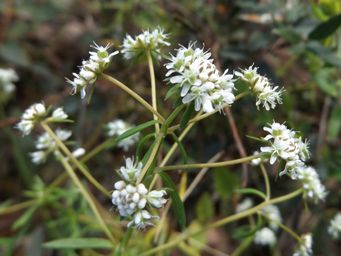


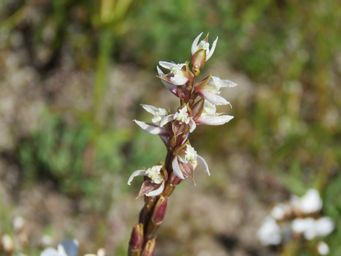
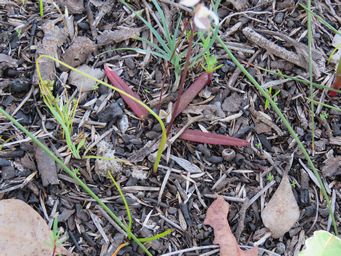
Prasophyllum fimbria, Fringed Leek orchid
A tall single stem up to one metre, with green flowers up its length, each with an upturned
frilly white labellum with purple colouring in the centre. Foliage consists an elongated pointed leaf which hugs the stem before
turning outwards. Stem colour varies from green to dark brown.
October
Tonebridge (Boyup Brook), South West region, Western
Australia, favouring winter wet areas, and flowering in much greater numbers following a burn. The occur around the coastal strip
from Geraldton to Esperance, extending a little further inland in the south west corner of the state.
Prasophyllum hians, Yawning Leek orchid, Djubac (which also applies to a number of orchids with an edible tuber).
A single stem of
up to fifty centimetres, with flowers up the entire length. Flowers are small and mainly white, dominated by a large upturned
pointed labellum with frilled edges. Stems vary in colour from green to maroon, coming from a single elongated narrow leaf.
October
Tonebridge (Boyup Brook), South West region, Western Australia, favouring winter wet areas, and mostly only flowering
following a burn. Found mainly along the coastal strip between Perth and Ravensthorpe, and extending into a number of Wheatbelt
locations.
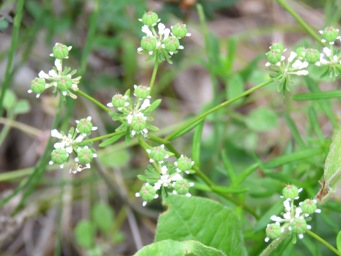
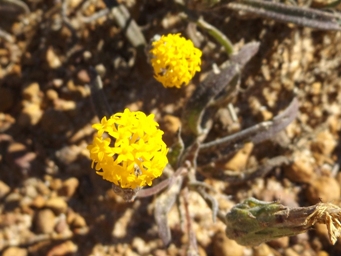
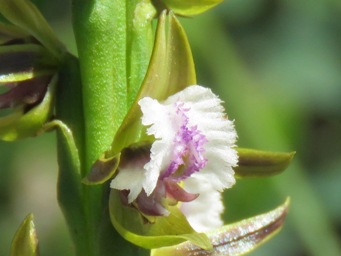

Podotheca angustifolia, Sticky Longheads, Sticky Heads.
Tiny plants with sticky bracts on a plump flower base, with tiny tufts of yellow
petals at the top. Narrow elongated leaves which also appear to be sticky. More frequently found following fires due to
reduced competition from large plants.
November
Yornup (Bridgetown-Greenbushes shire) in the South West region, Western Australia. Found
in suitable areas in the Gascoyne, Mid West, Wheatbelt, Perth and Peel, South West, Great Southern, and western Goldfields regions. Also found in the southern parts of South Australia, New South Wales, and in Victoria.
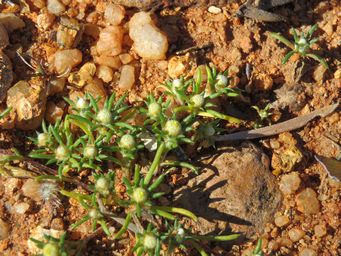


Pogonolepis muelleriana, Stiff Cup-flower, Stiff Angianthus, Salt Angianthus.
A ground spreading plant with tiny small white compound
flowers, cupped by cylindrical petals which terminate in a spike. These fluffy white flowers have a yellow centre when open,
and are two to four and a half millimetres across.
Seen south of Leinster, Leonora Shire, Goldfields region and Sandstone
in the Mid West region. Found in the Gascoyne, Mid West, Wheatbelt, into the Great Southern and Goldfields regions. Favouring
salt lakes, saline depressions, and claypans. Also found in South Australia, New South Wales, and in north western Victoria.
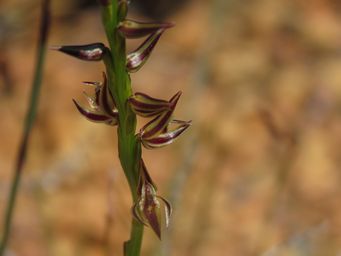
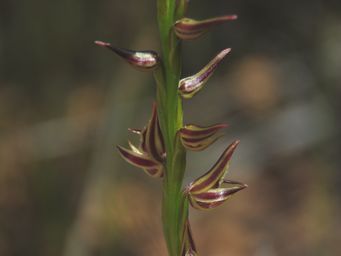
Prasophyllum drummondii, Swamp Leek Orchid, Djubac (which also applies to a number of orchids with an edible tuber).
Up to thirty
flowers along a single green stem, which can reach eighty centimetres in height. Flowers are reddish brown with yellow edging
to the petals. Labellum has frilly edges and points upwards. Leaf is a long cylindrical tube as long as the flower stem.
December
Northcliffe, Manjimup shire, South West region, Western Australia. Found in areas not too far from the coast, from Three Springs in the Mid West, Wheatbelt, Perth and Peel regions, South West, Great Southern, and coastal Goldfields east of Esperance. These orchids grow in swamps and winter wet areas, can be seen growing in water.
Psammomoya choretroides, Sand-loving Psammomoya
Broom-like shrub with tiny white flowers with cream/green centres, growing up the
stems, which grow to 45 centimetres.
August
Seen at Merredin in the Wheatbelt and Bunjil Rocks in the Perenjori Shire, Mid West
region. Occurs in the Mid West between Kalbarri and Perenjori, through the Wheatbelt, and the Western edge of the
Goldfields. Grows in sandy areas (Psammomoya meaning sand loving).
Prostanthera semiteres, Mint Bush, Mint Plant, Australian Mint Bush (these names apply to all species of Prostanthera). There
are two subspecies of Prostanthera semiteres. The photos here are most likely Prostanthera semiteres subsp. semiteres.
A small
shrub growing to 1.4 metres. Pink or red tubular flowers with stigma extending well beyond the tube. Narrow flat leaves
are nine to eleven millimetres long for subsp. semiteres but only two to six millimetres for subsp. intricata. Leaves are opposite.
August
Boorabbin National Park, which is between Southern Cross (Yilgarn Shire) and Coolgardie (Shire of Coolgardie), Western
Australia. While Prostanthera semiteres subsp. semiteres is only found in the Westonia and Yilgarn Shires, and Prostanthera
semiteres subsp. intricata occurs near Mullewa in the Greater Geraldton shire in the Mid West, the Wheatbelt shires of Koorda and
Mount Marshall, as well as the western part of Menzies shire in the Goldfields. Prostanthera semiteres also is found near Newdegate
in the Wheatbelt shire of Lake Grace, and north of Esperance in the southern Goldfields.



